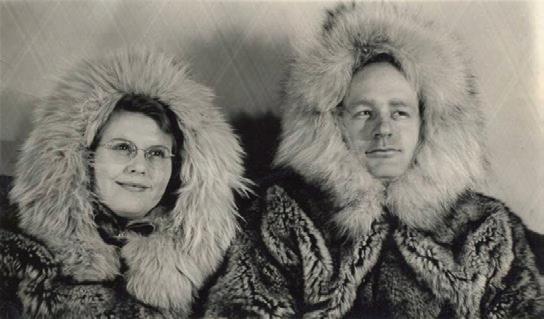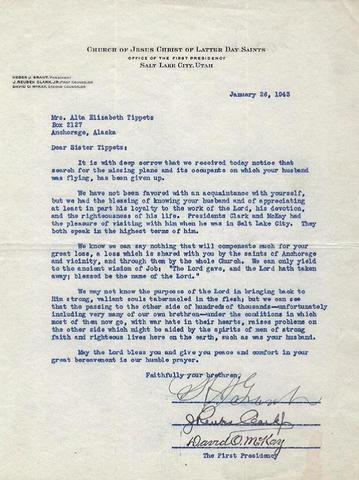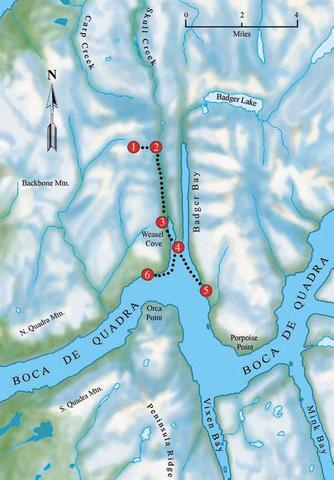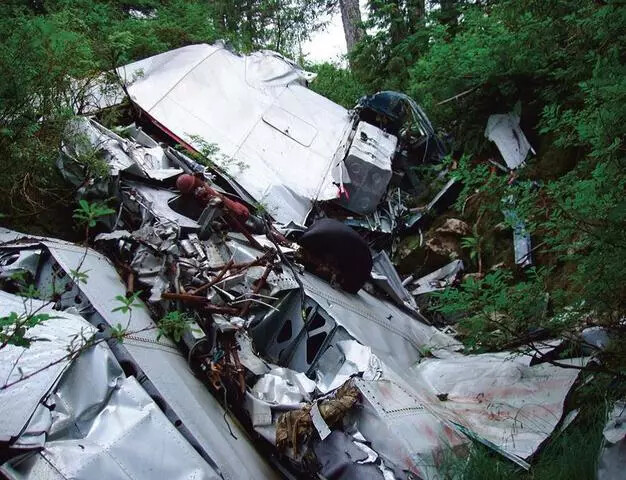After a small plane carrying Latter-day Saint Joseph Tippets and 5 others crashed in the harsh Alaska wilderness in January 1943, the tiny group of survivors—presumed lost at sea—would spend the next 29 days fighting for their lives.
The Lockheed Electra was losing altitude. Clear skies over Vancouver Island had given way to threatening clouds and turbulence along the Canadian coast. The pilot, Harold Gillam, could see ice collecting along both wings and knew he had a problem.
Suddenly, the left engine sputtered and quit. Gillam picked up the microphone and called Ketchikan Airport, “One engine conked out—expect trouble!” Glimpsing towering peaks directly ahead, he dropped the mike. Moments later, the plane, with five passengers on board, crashed into the side of a snow-covered mountain in southeast Alaska.
The aircraft was part of a fleet owned by the Morrison-Knudsen (M-K) Construction Company of Boise, Idaho. M-K was a large government contractor in Alaska, building everything from roads to airfields, and Harold Gillam was the company’s chief pilot. Gillam was well known for his daring exploits in the Alaska backcountry and for his uncanny ability to navigate in bad weather. Among the locals, he was known as “thrill ’em, spill ’em, but no kill ’em Gillam.”
Two of the passengers that day, Robert Gebo and Percy “Sandy” Cutting, also worked for M-K, and the third passenger, Dewey Metzdorf, owned a hotel in Anchorage. Passengers four and five were Susan Batzer, a stenographer for the Civil Aeronautics Administration (CAA), and Joseph Tippets, a radio engineer for the CAA and the first branch president of the Anchorage Branch.
A Futile Search
The group departed Seattle at about 1:30 P.M. on January 5, 1943. It was World War II, and the Japanese had bombed Dutch Harbor in the Aleutians and were still occupying two small islands, Attu and Kiska, so it was necessary to take precautions when flying along the coast. Alaska airfields routinely changed their radar signals to confuse the enemy; Gillam, unfortunately, was using an outdated chart and did not have the new coordinates. In the winter darkness, he was unable to determine exactly where they were; his legendary skills were no match for outdated charts and gathering ice.
Soon after the Electra went missing, the U.S. Coast Guard and Canadian authorities organized an extensive search from Prince Rupert to Sitka, Alaska, in the north. Using the average speed of the aircraft and the time of Gillam’s last message, they assumed the plane had gone down within a 60-mile radius of Annette Island.
On the ground and in the air, freezing rain, snow, and strong winds hampered the search. Bush pilots who had volunteered to help often encountered zero visibility. It was an anxious time for all—the newspapers in Seattle and Alaska were full of the story, but hope was gradually fading. Then, on January 26, three weeks after the crash, the search was officially abandoned; all on board were believed to have gone down in the sea.
At home in Anchorage, Joe’s wife, Alta, was convinced her husband was still alive. She recalled the circumstances of their separation: In late December, Joe received an urgent message. His elderly mother down in Utah was gravely ill and not expected to recover. His sisters were asking: could he come soon? Not an easy question to answer from Alaska in the middle of a war—but he would try. A few days later, he was on a flight to Seattle and then on to Ogden, where he made it in time to see his mother. A few days later, Joe was also able to visit with Church leaders in Salt Lake City, who were interested in the progress of the Church in Alaska.
Before returning, he wrote to Alta, “I miss you and love you and thank God for having you as my wife. Godspeed our quick reunion, and I hope I beat this letter to you!” He hadn’t made the reunion.

Friends came to console Alta and to gently urge her to take her 2-year-old son and return to her family in Utah. But Alta responded that she had been praying and had received an assurance that Joe would be found. No one could convince her otherwise. In Utah, family and friends were praying and fasting for Joe’s safety.
For Joe and his companions, who were still camped out under the wing of the broken plane, it was going to take superhuman courage and determination just to try and survive.
Fighting for Survival
Back on the frozen mountain, the men were saddened by the loss of Susan Batzer, the only female passenger. She had been badly injured in the crash and died on the second day. Gillam, well experienced in the Alaska outback, had decided he had the best chance of getting out to find help. On the fifth day, he gathered up a few supplies and vanished into the rugged terrain. They never saw him again.
The four remaining men, Robert Gebo, Dewey Metzdorf, Sandy Cutting, and Joe, now examined their options. Robert and Dewey were still recovering from several broken bones and could barely walk. Sandy Cutting and Joe were in the best shape, although all of them were gradually starving and suffering from exposure in the ice and snow. Joe later recalled the circumstances of their dwindling food supply:
I remember going into the plane one afternoon to search for leftovers from the lunch we had eaten just before the crash. I got down on the floor of the plane and went through it bit by bit, picking up crumbs of bread, frozen grapes, and disintegrated apples. I put them all on something and took this little tray back up under the wing where we were living. Given our circumstances, these little pieces of food were really a treat at the time. I thought for a while that frozen grapes must be the greatest thing since home cooking. We didn't have many, but they sweetened our mouths and renewed our spirits just a little.
By the third week after the crash, the group realized their only hope for survival was to somehow move their camp down to a lower elevation where the weather was less severe. With great effort and using one of the airplane doors as a sled, the men managed to make it to the valley floor. After setting up a new shelter at the edge of a forest, it was agreed that Joe and Sandy Cutting should hike out toward the bay and look for habitation. The other two men, unable to walk, would stay in camp with the remaining bouillon cubes and try to keep a fire going until Joe and Sandy returned. It was the most practical plan, but the future for all of them was uncertain.
Throughout his long ordeal, Joe never stopped praying. He later said, “One of the things I prayed for most was that my family would know that I had survived the crash and would hold on until being rescued.”
The following days brought a series of challenges. When Joe and Sandy approached the shore of Boca de Quadra, they discovered an abandoned cabin and a small, leaky rowboat on a spit of land called Weasel Point. Finding a can of tar in the cabin, they were able to patch up the boat and make a perilous round trip across the bay to an old fish cannery that looked promising, but to no avail. The next morning, they decided to embark on a much more dangerous endeavor. After repairing the boat further, they became bold and decided to use a narrow outlet, get into open sea, and try to get to Annette Island. They sat in icy water, bailing as fast as they were paddling, but they kept trying. In Joe’s words:
We should not have undertaken that trip. Before we left, I had a clear feeling that we should not go. It was more than a feeling, it was a warning. But we set out and, as a result, we were headed for disaster. Soon, a violent storm began to develop. The sky turned black and the waves got higher and higher. Nearly full of water, the boat capsized and we were dumped into the bay. Cakes of ice were floating all around us. We lost our overcoats, cooking utensils, everything but the clothing we had on and our rifle.
Our wet clothing was dragging us down and the waves tossed us around. Just for a moment, I lost all faith and was angry with the Lord. Why, I thought, have you let me go through so much, for so long, only to drown here today? But, almost as I completed that thought, with my head barely above water, I found my feet touching the bottom. Pushing off and trying to swim, we kept together and made it the short distance to the shore. But we found only rocky cliffs. . . . It took us more than a half hour to finally grasp a ledge and pull ourselves fully out of the water. Fortunately, in spite of everything, we had kept our matches in a bouillon cube tin sealed with adhesive tape, and they were dry. We made a small fire and tried to warm our feet. We then set out to try and return to our camp, encouraging each other as we went. After traveling some distance, we saw . . . our old boat. [In it] I found the valuable bundle containing my Bible, Book of Mormon, and documents wrapped in oil cloth. . . . Recovering these . . . seemed to be a small but special miracle. We . . . worked our way back to our campsite. It had been twelve hours since we had left. As we drew near the shelter, we saw a Coast Guard cutter circling the bay. Wildly, we ran toward shore, yelling, stumbling, and falling in desperation to get them to see us. But the boat went up the channel and right past Weasel Point before disappearing into the fog beyond. . . . Had we listened to the promptings not to start out that day, the boat would have picked us up. If I ever had any doubts that we would be found, it was then.
Joe’s Wife, Alta
It had now been almost four weeks since the Gillam plane had disappeared. The search had been abandoned. Despite Alta’s strong faith, members of the branch and the mission president in Portland, Desla Bennion, sadly informed Church leaders in Salt Lake City of Joe’s probable death. A letter of condolence was sent to Alta from President Heber J. Grant and his counselors, J. Rueben Clark and David O. McKay. (In a twist of fate, the letter arrived days after Joe was rescued.)

Captain Harold Johnson, Joe’s counselor in the branch presidency, and J. L. McCarrey, a lawyer and close friend, came by one day to see Alta. Cora McCarrey remembered her husband returning to the car after having visited with her. He said to his wife that “Alta has either totally lost it and is living in a dream world or she really has had a revelation and knows something that none other can hardly comprehend.” A young LDS soldier, Omer Smith, described how Alta kept her home as if her husband were just away on an extended trip. John Arrington also recalled, “I personally visited Sister Tippets at her humble home. Walking up a wooden walkway to the door of a small cottage … I expressed the sympathies of the membership of the branch. I will never forget her comments: ‘Jack, don’t you be too concerned because Joseph will yet be found alive.’ What faith she had.”
Rescued
Ultimately, amazingly, the faith and prayers of many people were answered when Joseph Tippets and Sandy Cutting were rescued from a remote beach near Boca de Quadra Inlet on February 3, 1943—29 days after the crash. Joe and Sandy’s bonfire was spotted by the crew of a small Coast Guard vessel, the Tucsan, which the captain later said had no real reason to be in that area.

In Anchorage, there was pandemonium as word spread through the CAA offices and corridors. “Men were weeping unashamedly; the girls were laughing, crying, and embracing one another. Needless to say, work was at a standstill. Never have I seen such a display of happy relief,” said Chandler Griggs, one of Joe’s colleagues.
The next morning, despite the doctors’ advice, Joe and Sandy insisted on joining the Coast Guard search team and going back into the wilderness to find their two companions. They knew they had the best chance of locating them. When they were finally discovered, Bob and Dewey were barely alive, surrounded by melting snow. Two days later, they were brought down the mountain on toboggans. Despite frostbite and broken bones, both men would recover their health.
The incredible rescue and story of survival made headlines across the nation, with wire reports and photos in the New York Times. It was welcomed as a story of heroism, courage, and endurance at a time when many were weary of news from the war.
A few weeks later, in March 1943, the Heber City Third Ward chapel was filled to overflowing when Joseph Tippets returned to express his appreciation and to share some of the details of his ordeal. “He recounted his experiences, keeping us spellbound for a long time, giving credit for his survival to the constant prayers on his behalf,“ said one attendee, Phil Giles.

The Aftermath
In giving all he could to God and country, Joseph rose through the ranks of the Civil Aeronautics Administration, transferring from Alaska to Washington, D.C. in 1947. He helped establish air navigation standards and was involved in the development of Dulles International Airport. The CAA became the Federal Aviation Agency (FAA), and Joseph reached the highest levels of civil service responsibilities as the FAA Western Region director.
In his Church callings, Joseph continued as the Anchorage branch president until 1947, served as a much-loved bishop of the Capitol Ward in Washington, D.C. (1949-1953), and as a counselor in the Washington, D.C. stake presidency (1957-1961).
At Joe’s funeral in 1968, FAA Administrator David Thomas, his longtime friend and colleague, told this story:
I was back in the bush in Alaska and an old grizzled prospector came up to me and said, "I hear you're from Washington, D.C." I said, "I am." He said, "It's a big town, isn't it?" and I said, "Yes, it's a big town." He said, "It's probably so large you never heard of a man named Joe Tippets. He was the finest man that was ever in Alaska."
When reflecting back on his miraculous survival, Joe often expressed a hope that his story would inspire courage in others who were facing difficult circumstances, and increase faith in the power of prayer. More than 60 years later, that hope continues to be fulfilled.
Scouting Saves a Life
In a 1966 interview on a Salt Lake City KUED TV program, Joseph Tippets told host Neal A. Maxwell about some of the skills that kept him alive. Joe described coming back to Utah a few weeks after the accident to spend time with family and says that one of the first people he went to see in Ogden was Brother Jesse Draper, who had been his scoutmaster. He wanted to thank him for his patience and his teachings, and for his lessons on keeping dry matches! Joe attributed much of his ability to survive the treacherous month in the Alaska wilderness to the skills he learned from Brother Draper.
Joseph then commented to Brother Maxwell that youth leaders should not despair when kids do not seem to appreciate their efforts because some knowledge is getting through. In Joe’s case, that knowledge saved his life.
This article originally appeared in the May/June 2009 issue of LDS Living.

